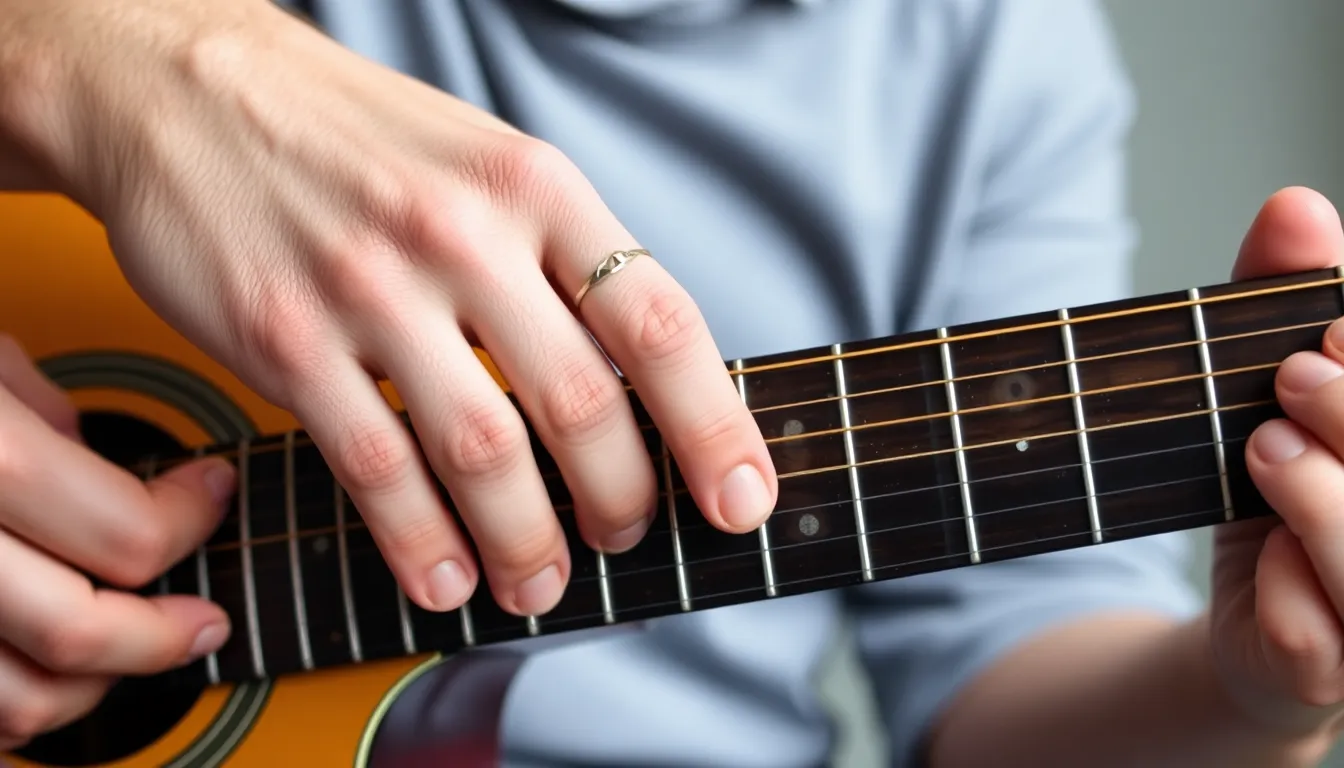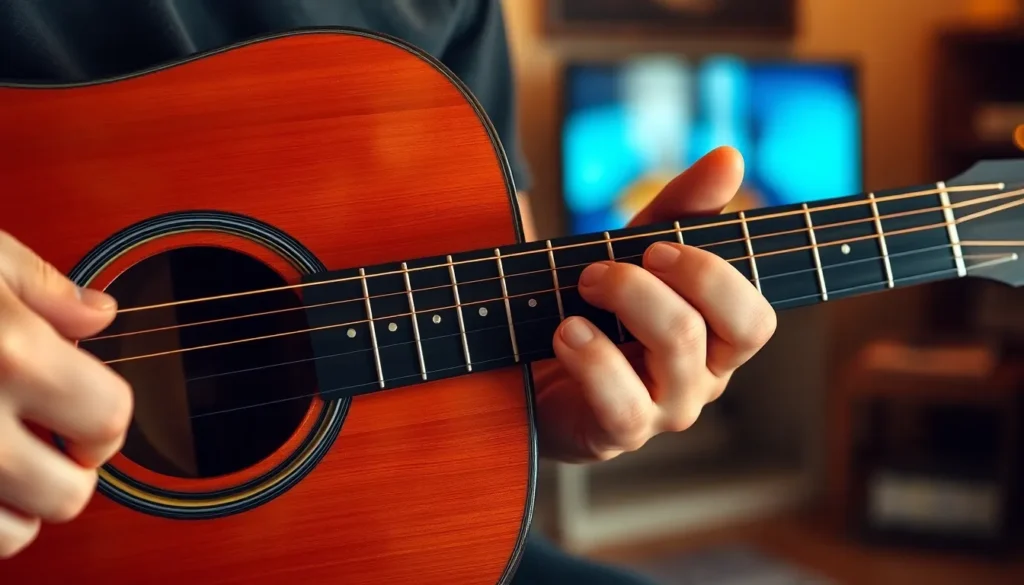Table of Contents
ToggleThe D minor 7 chord might just be the secret sauce your guitar playing has been missing. With its rich, jazzy flavor, this chord adds a touch of sophistication to any song. Whether you’re strumming in your living room or jamming with friends, mastering the Dm7 can elevate your sound from “meh” to “wow!” faster than you can say “guitar hero.”
Overview of D Minor 7 Guitar Chord
D minor 7, often written as Dm7, combines four specific notes: D, F, A, and C. This chord creates a rich, warm sound that musicians appreciate in various genres. It functions as both a tonic and a seventh chord, adding depth and complexity to compositions.
Fret placement for Dm7 changes slightly depending on the version played. The most common voicing uses the following placements: index finger on the first fret of the high E string, middle finger on the second fret of the G string, and ring finger on the third fret of the B string. Players can also opt for barre chords, where the index finger bars across the fifth fret, creating a full sound.
Theory behind the D minor 7 chord emphasizes its role in jazz, blues, and rock music. Jazz musicians frequently use it to create progressions, enhancing emotional impact. Blues artists often incorporate it for a soulful feel, while rock musicians appreciate its versatility.
Practicing Dm7 transitions to other chords strengthens a guitarist’s skills. Trying common transitions, such as moving from Dm7 to G7 or Cmaj7, encourages familiarity with different progressions. Incorporating various rhythms while strumming adds further complexity, refining the player’s technique.
D minor 7 stands out due to its multifaceted applications and emotional depth. Musicians grow both technically and creatively through its use, exploring new sounds and expressions. Mastering Dm7 elevates guitar playing, whether performed solo or in ensemble settings.
How to Play the D Minor 7 Guitar Chord

Playing the D minor 7 chord requires specific finger placements for effective sound production. It’s important to position the fingers accurately to capture the chord’s unique essence.
Finger Positioning
Place the index finger across all strings at the fifth fret, forming a barre. The middle finger should press down the sixth fret of the G string. Next, position the ring finger on the seventh fret of the A string. Finally, the pinky finger should touch the eighth fret of the high E string. This configuration allows the notes D, F, A, and C to resonate harmoniously. Ensuring fingers remain close to the frets minimizes buzzing. Practicing these placements fosters muscle memory, promoting stronger chord transitions.
Common Techniques
Incorporating rhythm and strumming techniques enhances playing the D minor 7 chord. Use a combination of downstrokes and upstrokes for a dynamic sound. Swinging between these strokes produces a lively feel. Muting the strings with the palm of the strumming hand offers versatility in sound. Experimenting with fingerpicking introduces an intricate texture. Additionally, practicing transitions from Dm7 to other chords like G major or A minor deepens musical skills. Regularly using the Dm7 chord in progressions creates familiarity, impacting overall confidence during performances.
Chord Variations
D minor 7 chord offers various ways to play, enriching its sound and suitability for different musical contexts.
Alternate Voicings
Exploring alternate voicings produces diverse textures. One popular voicing involves the open position, where the player frets D on the fifth string, F on the fourth string, D on the third string, and leaves both the second and first strings open. Another option uses the seventh fret, creating a fuller sound. This voicing requires the index finger on the fifth fret of the A string, the ring finger on the seventh fret of the D string, and the middle finger on the sixth fret of the G string. Each voicing highlights unique tonal qualities that enhance the chord’s versatility.
Barre Chord Version
Utilizing the barre chord version opens new possibilities. A common variation starts with barring all strings at the fifth fret with the index finger. The middle finger positions on the sixth fret of the G string, while the ring and pinky fingers press the seventh fret of the A and D strings respectively. This configuration helps maintain the chord’s rich sound across different fret positions. The barre chord form provides a powerful harmonic foundation, making it ideal for genres ranging from jazz to rock. Players can confidently use this voicing in various musical scenarios.
Application in Music
The D minor 7 chord appears in various musical contexts, showcasing its versatility and emotional resonance. Musicians frequently utilize this chord to enhance compositions across genres.
Popular Songs Featuring D Minor 7
Numerous songs prominently incorporate the D minor 7 chord. For instance, “Ain’t No Sunshine” by Bill Withers uses it to evoke a somber atmosphere. A well-known example in jazz is “Blue in Green” by Miles Davis, which relies on Dm7 for its lush harmonic backdrop. Additionally, “Hotel California” by the Eagles features the chord, contributing to the song’s haunting quality. From pop to jazz, the Dm7 chord enriches these tracks with depth and sophistication.
Genre-Specific Uses
In jazz, the D minor 7 chord often serves as a staple, providing a strong foundation for improvisation. Musicians frequently pair it with dominant chords to create tension and release. Blues players also embrace Dm7 for its emotional depth, enhancing expressive solos and chord progressions. Rock music artists use this chord to add emotional texture, particularly in ballads. The versatility of D minor 7 makes it a key component across diverse genres.
Tips for Mastering the D Minor 7 Guitar Chord
Focusing on finger positioning is crucial for playing the D minor 7 chord effectively. Ensure the index finger forms a barre at the fifth fret. The middle finger should press the sixth fret of the G string. Place the ring finger on the seventh fret of the A string, while the pinky rests on the eighth fret of the high E string. This arrangement helps create a harmonious sound.
Practicing varied strumming patterns enhances the chord’s expressiveness. Incorporate a mix of downstrokes and upstrokes to add dynamics to playing. Muting unwanted strings can also contribute to a cleaner sound. Experiment with fingerpicking techniques for different textural effects.
Building smooth transitions to and from the D minor 7 chord promotes fluidity in playing. Work on transitioning to chords like G major or A minor. Repeated practice of these transitions develops muscle memory, increasing confidence during performances.
Exploring alternate voicings further enriches the D minor 7 chord. In open position, the chord produces a brighter tone. At the seventh fret, another voicing offers a unique sound. Learning the barre chord version, starting with barring all strings at the fifth fret, showcases power and versatility for various styles.
Listening to songs featuring the D minor 7 chord provides practical insights into its application. Tracks like “Ain’t No Sunshine” and “Hotel California” highlight its emotional resonance. Recognizing genre-specific uses, including jazz and blues, sheds light on the chord’s role in enhancing expressive musical lines. Focus on these aspects to strengthen overall guitar skills and musical understanding.
Mastering the D minor 7 chord opens up a world of musical possibilities. Its rich sound and emotional depth make it a valuable addition to any guitarist’s repertoire. By practicing various voicings and incorporating it into different musical styles, players can enhance their creativity and technical skills.
Exploring the Dm7 chord not only enriches performances but also deepens the understanding of music theory. As musicians grow more comfortable with this chord, they’ll find it seamlessly fits into their playing, whether in jazz, blues, or rock. Embracing the D minor 7 chord can truly elevate the quality of their music, making it more expressive and compelling.







